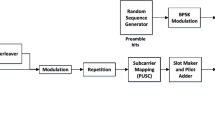Abstract
MIMO (Multiple Input Multiple Output) scheme uses transmit diversity technique which results in high throughput with increased channel capacity. The complexity of MIMO system increases the area and power requirements of the system. The proposed work is to achieve good spectral efficiency and reduction of interference by introducing multiwavelet with MIMO technology. The improvements directly results in reduction of BER (Bit Error Rate) for a given SNR (Signal to Noise Ratio). Implementation of the proposed scheme in FPGA (Field Programmable Gate Array)—virtex5 (xcvlx30t-1f665) shows a considerable improvement in speed and area when compared with the existing methods.










Similar content being viewed by others
References
Achaichia, P., Le Bot, M., & Siohan, P. (2011). OFDM/OQAM: a solution to efficiently increase the capacity of future PLC networks. IEEE Transactions on Power Delivery, 26(4), 2443–2455.
Ahmed, S., & Kawai, M. (2011). Interleaving effects on BER fairness and PAPR in FDMA. Telecommunication Systems. doi:10.1007/s11235-011-9557-6.
Chui, C. K., & Lian, J.-A. (1996). A study of orthonormal multi-wavelets. Journal of Applied Mathematics, 20, 273–298.
Chung, J., Yun, Y., & Choi, S. (2011). Experiments on MIMO-OFDM system combined with adaptive beamforming based on IEEE 802.16e WMAN standard. Telecommunication Systems. doi:10.1007/s11235-011-9475-7.
Communication block set, convolutional encoder. Available from www.mathworks.com/access/helpdesk/help/toolbox/commblks/.
Dietze, K., Hicks, T., & Leon, G. EDX WiMAX system performance studies. Wireless, LLC. Eugene, Oregon, USA.
Huan, N. C., Tung, N. T., & Duc, N. T. (2003). Bit and packet error rates in Rayleigh channel with and without diversity (Project report). Aalborg University Institute of Electronic Systems Department of Communication Technology.
IEEE 802.16 Published Standards and Drafts. Available from http://wirelessman.org/published.html.
International Telecommunication Union. (2002). Recommendation. ITU-R M.1225. Guidelines for evaluation of radio transmission technologies.
Janakiraman, M. (2004). Space time codes and MIMO systems. Boston: Artech House Publishers.
Jiang, R. M. (2007). An area-efficient FFT architecture for OFDM digital video broadcasting. IEEE Transactions on Consumer Electronics, 53(4).
Juan, I., Del-Castillo, M., Santos, A., & Villalón, J. M. (2011). Evaluation of OFDMA resource allocation algorithms in broadband wireless access networks. Telecommunication Systems. doi:10.1007/s11235-011-9598-x.
Li, X., Lai, Z., & Cui, J. (2007). A low power and small area FFT processor for OFDM demodulator. IEEE Transactions on Consumer Electronics, 53(2), 274–277.
Mach, P., & Bestak, R. (2008). WiMAX throughput evaluation of conventional relaying. Telecommunication Systems, 38(1–2), 11–17. doi:10.1007/s11235-008-9093-1.
Maehara, F. (2005). Series expression of BER performance for DQPSK/OFDM signals employing selection combining diversity reception over nonlinear fading channels. In Proceedings of IEEE VTC 2005- spring (Vol. 2, pp. 1007–1011).
Ramachandran, L. (2001). Image compression using balanced multiwavelets. Department Electrical and Computer Engineering, Master’s thesis, Virginia tech.
Salih, S. M. (2011). BER reduction for DMT-ADSL based on DMWT. Journal of Science and Engineering, 8(2), 237–254.
Simoes, & Luis M., M. (2008). Optimal data transmission on MIMO OFDM channels. Master’s thesis. Naval Postgraduate School Monterey, CA.
Soman, K. P., & Ramachandran, K. I. (2005). Insight into wavelet theory to practice (2nd ed.). New Delhi: Prentice-Hall of India.
Strela, V. (1996). Multiwavelet theory and applications. Ph.D. Thesis, MIT.
Tahat, A. A. (2010). A matrix scheme to extrapolation and interpolation for a 4G MIMO OFDM system. In Proceedings vehicular technology conference fall (VTC 2010-fall). New York: IEEE. (pp. 1–5).
Wen, H., Gong, G., Chao, S., & Ho, P.-H. (2011). Framework for MIMO cross-layer secure communication based on STBC. Telecommunication Systems, doi:10.1007/s11235-011-9540-2.
Yoshizawa, S., Yamauchi, Y., & Miyanaga, Y. (2008). A complete pipelined MMSE detection architecture in a 4x4 MIMO-OFDM receiver. In IEEE international symposium on circuits and systems (ISCAS) (pp. 2486–2489).
You, M. (2004). An application of multi-wavelet packets in digital communications. In Proceedings second annual conference on communication networks and services research (pp. 10–18).
Author information
Authors and Affiliations
Corresponding author
Rights and permissions
About this article
Cite this article
Vidhya Lavanya, R., Madheswaran, M. Wimax (IEEE 802.16 m) system based on space time block code and discrete multiwavelet transform and implementation in FPGA. Telecommun Syst 56, 327–334 (2014). https://doi.org/10.1007/s11235-013-9846-3
Published:
Issue Date:
DOI: https://doi.org/10.1007/s11235-013-9846-3




